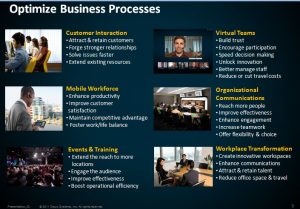
Our world is changing rapidly every day and to keep on top of these changes, we need to continuously look at our ability to collaborate to solve business issues. Some key trends we are seeing in the workplace include:
Customers today communicate about brands on Facebook, Twitter and other social media tools. Positive or negative comments can be shared with other customers in real time. Conversations about your brand can happen with or without you. Traditional, reactive customer service tools will not insert you into the conversations and help you build relationships. Companies now need to monitor what’s being said about them and directly reach out to customers in real time.
Many IT departments have implemented desktop virtualization to reduce Total Cost of Ownership (TCO) and improve their data security. While the current environment may provide adequate data access to corporate applications while in the office, they need an architecture that enables rich video and voice Unified Communication applications, and to be able to access them from a mobile environment—an integrated Unified Communication over a VDI link, with optional mobility.
Saleseople are increasingly mobile and want to use their Smartphones and tablets to communicate with customers, view documents, get management approvals, and stay in touch from any location. To do so, companies need to implement an architecture that supports any of the new generation devices natively (including as-yet unannounced ones), allowing highly productive collaboration from anywhere, anytime.
Collaboration is driving the next wave of business growth, innovation and productivity. Cisco is innovating in the collaboration space to meet today’s business needs for a more collaborative workspace – one that is inherently more Mobile, Social, Visual and Virtual. We are deeply involved in standards development and adoption and our R&D investment in collaboration is over $1 billion per year. Over 25% of our R&D investment in Unified Communication drives interoperability.
Cisco is uniquely delivering secure, inter-company collaboration solutions across all mediums – video, voice, presence/IM, email –which maximize existing IT investments. Our Collaboration Architecture, based on the network, provides the best possible experience across Any Device, in Any Location, with Any type of Content.
Collaboration is most effective when linked to key business objectives. The key guideline is to develop relationships with your key stakeholders to understand their business imperatives and how collaboration can further those goals. Some additional guidelines we use are to:
Develop a collaboration strategy and an architecture that will support it. An architectural approach will ensure that you have an ability to accommodate future growth, or changes in devices, applications or client strategy.
Have a long-term strategy for collaboration and how it can enable your business needs. What role do video, social software, mobility and presence need to play in your business?
Assess the value of new deployment options that leverage cloud or hosted models. Understand your deployment options and the flexibility they can provide.
View collaboration as a journey, not a project. This will allow you to try and see what works best in your organizational culture and implement course corrections along the way.
The most important factor is to start that journey today. What are the key opportunities and challenges that collaboration can help you address? There are simple changes—like adding expertise tagging to a corporate directory, setting up wikis, or providing for an internal YouTube—are quick ways to begin to provide enhanced collaboration capability with low risk and culture change. These types of wins are important to demonstrate what collaboration can do for your organization.
